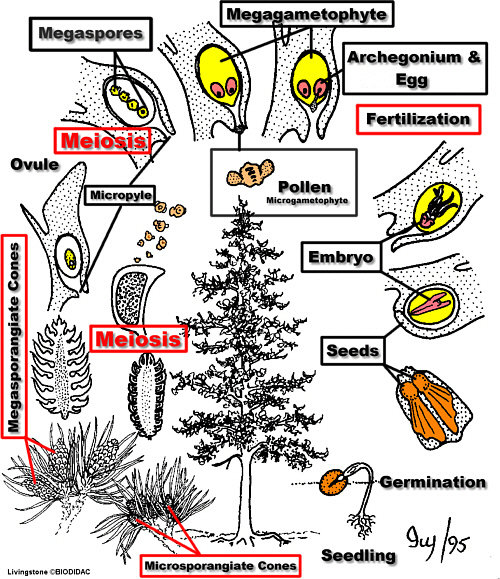Let’s Rely on Each Other
Redwoods are monoecious,
meaning both male (pollen-producing) and female (seed-bearing)
cones are borne on the same tree but on different branches. The
pollen is shed in winter or in spring, whereas the mature,
fertilized ovulate cones ripen in early fall to shed their seeds
in late fall and early winter. Cones are only produced after
they reach the canopy and can use direct sunlight for energy.
Redwood cones are only about one inch long. Each cone holds
between 14 and 24 seeds. The seeds are so tiny that you would
need over 100,000 seeds to weigh one pound! Redwoods start to
bear their seeds when they are about five to fifteen years old.
The cones dry under conditions of low humidity and release their
seeds. Rains normally speed up seed dispersal. The seeds are normally
ready to germinate soon after they have fallen to the ground, as
long as the soil is moist and the weather is warm enough.
Studies have shown that seed viability increases with the age of
parent trees. Maximum seed viability was reached when trees were
over the age of 250 years. On the other hand, seeds produced by
trees under twenty years old were less than one percent viable.
One tree can produce six million seeds in one year. However,
less than 5% of these seeds germinate, and only a few of these
end up growing into seedlings. Failure usually results from
parasitic fungi, summer drought, or other causes.
Young trees are capable of sprouting from their parent’s
roots, benefiting from the root system already present, along with the
energy and nutrients contained inside. They could also sprout from
dormant buds in the burls at the base of a tree or from fallen
trees.
Redwood
burls
are gnarled structures that form from axillary
buds on seedling redwoods(left). In addition, if a tree is cut or burned,
a family circle of trees may grow up from the stump(below). Stumps of
small, young trees sprout more readily than those of large, old
trees. Because the root systems are already established, these
sprouts grow more vigorously than seedlings
and therefore are the
more common form of reproduction.
This way of reproduction results in trees that are
genetically identical to the previous tree.
The coast redwood lives
incredibly long, grows taller than any other tree species in the
world, and is exceeded in bulk by only the
giant sequoia. Becoming
sexually mature at the age of 10 years or less, the redwoods
continue to grow in volume for hundreds and hundreds of years. The
oldest redwood found so far, according to the growth ring counts, is
almost 2,200 years old. Although, on average, redwoods seldom live
more than 2,000 years, which is two-thirds as long as giant
sequoias, and only half as long as
bristlecone pines.
Secondary
growth of individual young trees can be extremely fast or very slow.
Where competition is high, the annual diameter increase could be
less than one millimeter. On the other hand, where competition is
not a problem, the diameter could increase by more than 2.5 cm in
one year.
The life cycle of a conifer.
Now that you've learned all about the reproduction of the coast redwood, it is time to discover the many connections this tree has with other organisms. If this sounds like something you'd be interested in, go to Interactions with Other Species.
Go back to Nutrition.
Home Sweet Home
